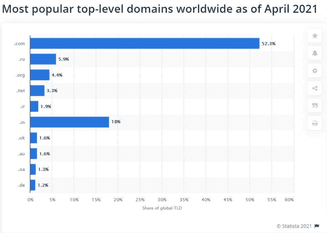- Osome Blog SG
- What Is a Domain Name and How To Choose the Perfect One?
What Is a Domain Name and How To Choose the Perfect One?
- Modified: 29 April 2025
- 8 min read
- Better Business


Syahirah Aiman Abbas
Author
Syahirah Aiman Abbas is a writer and translator who loves languages. After learning Malay, English, Arabic, Indonesian and French, now she is on to Turkish!
A domain name is an identity and the address for customers to know your ecommerce businesses. It shapes the ecommerce’s brand, and most likely the first gateway to the brand that users first get an impression of. Choosing the perfect domain name is important for your ecommerce business.
By the way, as you build up your ecommerce business, you will need to register your company too. We can help you with incorporating your company and also keep up with your accounting work as you grow your business. Just drop us a message to know more. Otherwise, do read on.
What Is a Domain Name?
To visit a website, we need to type in its domain name in the browser URL bar. It is the address to reach a particular website. Essentially, a domain name is made of three basic parts: server name [dot] second-level domain (SLD) [dot] top-level domain (TLD).
Example
For example, in the domain name www.google.com,
Server name: www, stands for the World Wide Web.
It's the server name used for websites, which is different from email, FTP or other services.
Second-level domain (SLD): google.
The SLD is the name of the website personalized to identify your business.
Top-level domain (TLD): .com.
The TLD is registered along with the SLD and is at the end of your website's unique web address. Examples for TLDs are .com, .net, .org and more.
How To Choose the Perfect Domain Name?
1 Check Domain Availability and Pricing
The Verisign industry brief stated that there are over 370 million registered domains that are active by the end of 2020. About half of those are websites end with .com and .net.
When creating an ecommerce website, it is quite likely that the domain name you are vying for is already taken. Thus, if you are considering a few domain names and you find that they are cheap currently, it doesn’t hurt to get them first and let them expire if you change your mind later.
Most web hosting companies offer domain registration too, and some even extend free domain registration for new hosting accounts. Free domain registrations are often offered for the first year, and subsequent renewals are usually charged at USD $14 annually. Bluehost and HostGator, for example, are web hosting companies with domain registration options.
If you need only domain registration without web hosting, you could buy your domain name from a domain name registrar like Domain.com, Network Solutions, and GoDaddy.
Domain name generators are a useful help to suggest top-level domain names best suited for your ecommerce online business. Lean Domain Search suggests available names by keywords you input, and Name Mesh does the same but you could add multiple keywords.
2 Pick “.com”
The most common domain suffix is .com. According to Statista.com, 52.3% of all websites use .com domain suffixes.

The .com TLD is the most widely adopted and recognized TLD. Although it might seem conventional and boring, if you were to ask internet users to type in a website address without providing the TLD, most probably all of them are going to type in a .com at the end of the domain name.
As such, even Google leans towards giving a .com domain more authority over other domain suffixes: purely because of human interaction. Our built-in association and familiarity with the .com top level domain (TLD) mirror the results that Google presents us with such domains.
When in doubt, choose .com (that is if it is still available!). You could then just concentrate on building your brand.
3 Pool in other Domain Extensions
To hedge your bets and protect your brand, you could consider taking other TLD extensions too alongside the .com of your website. For example, Google.net, Google.co and Google.info will all lead you to Google.com.
This is because visitors who type in the wrong extension would still reach your page, and you would not lose traffic to your website. Buying other domain extensions would also keep competitors at bay: they wouldn’t be able to take up the same domain name in other extensions, especially if your domain name is a generic one.
4 Short name + easy spelling = easier to remember
When deciding on a name for your ecommerce website, pick one which is short, catchy and easy to remember with no double meanings or weird spellings. Try to keep your domain name between 6-15 characters. The reason is that, as an ecommerce store, you are building your brand and want customers to recall your website when purchasing online.
The best way to test whether your domain name is easy to type and recall is by doing the radio or echo test. Say out your domain name to strangers, friends or families verbally, and see if they can type it out or write it down. If they ask you to repeat your desired name or request that you spell it out for them, you should consider revising your choice.
A bonus is when you could choose a name that directly or indirectly suggests to people the products you sell or services you offer. One way to do this is by adding your profession after your name in the second-level domain. For example, if your name is Aziz and you are a tailor, you could consider AzizTailor.com for your domain name.
5 Avoid slang or “cute” spellings
Do not use odd words, weird spellings and words which mean something else in slang or foreign language. Number letter combinations should be avoided because visitors would be unsure if they are spelt out or in numbers. Text-style abbreviations (e.g. GTG, OTW, CYA, ‘U’ instead of ‘you’) would make your brand seem less professional and unoriginal.
Similarly, acronyms are more suitable for an extremely well-established brand rather than a new ecommerce store, as they are harder to recall and do not espouse intrinsic or emotional value.
6 Avoid slang or “cute” spellings
Keep in mind that there are no spaces in domain names when brainstorming for a domain name for your ecommerce website. Including hyphens is a bad idea too; not only you might lose visitors if they forgot to type in the hyphen, but also because most people are accessing websites through their phones. To type a hyphen, the user must tap additional times or hold on longer on her mobile keyboard to type in the special character.
Forgetting that there are no hyphens or spaces in domain names before clicking on ‘Buy Now’ on the domain registration website might also be embarrassing in the future. Here are a couple of examples to illustrate:
- IT Scrap – “www.itscrap.com”
- Speed of Art – “www.speedofart.com”
The choices of names above also can be read as ‘crap’ and ‘fart’.
Reviewing your website name choice and running through your idea with another person would be useful in these cases.
7 Be mindful of trademark and copyright
It is a good idea to check with the patent, trademark and intellectual property websites of your country, and then worldwide, that your chosen domain name is not a registered trademark. This is to avoid you from getting into any copyright infringement issues in the future, especially if you are thinking of a global expansion.
Websites such as the World Intellectual Property Organization (WIPO) website and Trademarks411 could help you in this process. You might also discover how people will both consciously and unconsciously associate your brand with this step.
Generally, invented and compound words are most likely available and easier for you to trademark your brand (e.g. Ikea, Colgate, Facebook, YouTube, and Qantas). Therefore brainstorming sessions for your ecommerce domain could pay off!
8 Verify social media handles availability
You could use the online tool knowem.com to see if your domain or brand name is available across all social media platforms that you would use as part of your digital marketing plan. If you wondered why it's best to keep domain names under 15 characters: Twitter handles (usernames) have a 15 character limit if you would like to use Twitter to interact with your customer base. It would make the most sense for your ecommerce business to have identical handles across all online platforms to avoid confusion among your customers.
9 Use SEO keywords in domain names
When it fits your brand and is relevant to your ecommerce business, you should use SEO keywords in your domain name itself. Having relevant keywords in your domain name would help in search rankings.
HigherVisibility conducted a domain SEO study in 2017 and found that 63% of domains with top search rankings have some SEO keywords in them. In the food and beverage industry, for example, 71% of the top domains have keywords in them.
To illustrate, if your ecommerce store name is Hope and you sell mainly shirts, you could put Hopeshirts.com as your domain name. This can rank you better on search engines and differentiate your brand.
Examples of Good Existing Domain Names/Brands
Top domain names are either “brandable” or “discoverable” according to this piece by Smashing Magazine.
“Discoverable” websites or domain names are those that you get on the search result page when you type in the keyword for a certain topic, product or service. They are mostly generic and descriptive terms or names.
On the other hand, a “brandable” domain name evokes certain emotions and conveys a certain idea. People searching for that particular term would get to that particular website and nowhere else (think Nike). Although you wouldn’t get traffic from a generic name search, your website would be the top result from the search of your domain name, and this would translate to credibility for your brand.
Generally, if you are willing to invest more in generating buzz and paying for paid listings, go for a “brandable” name. If you are strapped on a budget for your marketing plan, then a “discoverable” name might work better for you as a search for a particular word or phrase would translate into higher chances of your website garnering a visit.
To get a feel of top brands or domain names that are still relevant over the years, you could consult the Fortune 500 list as they list the best performing companies globally. According to SimilarWeb, the top 5 websites as of 1 April 2021 are Google.com, YouTube.com, Facebook.com, Twitter.com and Instagram.com. Let us examine why they are good domain names:
- Compound words: YouTube and Facebook are compound words. Both consist of two nouns that we are familiar with. That’s why they are so easy to remember: we use them in our daily conversations.
- Portmanteau: Instagram is a portmanteau of “instant camera” and “telegram.” Initially called Burbn, co-founder Kevin Systrom wanted the name to be easy to pronounce, spell and follow the “right here, right now” concept and changed it to Instagram.
- Made-up name: Google is a misspelling of a real-life mathematical term, googol. It is 1 with 100 zeros. Although we warned against using weird spellings, the Google brand is so distinctive now that it is a verb for searching for something online. Made-up names are easier to trademark too.
- Single descriptive word: Jack Dorsey, co-founder of Twitter actually came up with the idea during a day-long brainstorming session (remember how we mentioned brainstorming sessions could be fruitful?). The original name was called “Status,” but flipping through the dictionary, he chanced upon Twitter -“a short burst of inconsequential information, and chirps from birds”- which was perfect for his online messaging service. Inspired by Flickr, Dorsey named it “twttr” but changed back to Twitter for simplicity.
What To Do if Your Preferred Domain Name Is Taken?
If your chosen domain name is taken, consider other top-level domain suffixes. It is fine. Although the .com is the best, getting other top-level domains for your brand could work well for you too. A good case in point is that the country extension .in for India. .in has 18% of all websites registered globally using that suffix, far ahead of the long- and well-established .org (4.4%) and .net (3.3%).
These are other options for you to consider:
- .city: If your ecommerce serves a specific city, this is a good choice. For example, .london or .boston.
- .country: Retailers who plan to expand globally could opt for this. Examples include .co.uk, .hk, .sg.
- .co : A global alternative for .com across all languages and cultures.
- .org: Most suited for non-profit businesses.
- .shop : Ecommerce websites could consider this because it’s clear and direct.
- .store : Another good choice for online retailers and small enterprises.
- .trade: Ideal for wholesalers or business-to-business (B2B) ecommerce stores.
After you have registered your domain names, you can incorporate your business with us at Osome. We also provide business support services such as corporate secretary tasks and accounting for ecommerce companies.







